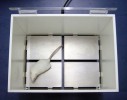Authors
J. P. R. Jacobsen, P. Weikop, H. H. Hansen, J. D. Mikkelsen, J. P. Redrobe et al.
Lab
Neurosearch A/S, Department of In Vivo Pharmacology, Ballerup, Denmark.
Journal
Genes, Brain and Behavior
Abstract
SK3 K+ channels influence neuronal excitability and are present in 5-hydroxytryptamine (5-HT) and dopamine (DA) nuclei in the brain stem. We therefore hypothesized that SK3 channels affect 5-HT and DA neurotransmission and associated behaviors. To explore this, we used doxycycline-induced conditional SK3-deficient (T/T) mice. In microdialysis, T/T mice had elevated baseline levels of striatal extracellular DA and the metabolites dihydroxyphenylacetic acid and homovanillic acid. While baseline hippocampal extracellular 5-HT was unchanged in T/T mice, the 5-HT response to the 5-HT transporter inhibitor citalopram was enhanced. Furthermore, baseline levels of the 5-HT metabolite 5-hydroxyindoleacetic acid were elevated in T/T mice. T/T mice performed equally to wild type (WT) in most sensory and motor tests, indicating that SK3 deficiency does not lead to gross impairments. In the forced swim and tail suspension tests, the T/T mice displayed reduced immobility compared with WT, indicative of an antidepressant-like phenotype. Female T/T mice were more anxious in the zero maze. In contrast, anxiety-like behaviors in the open-field and four-plate tests were unchanged in T/T mice of both sexes. Home cage diurnal activity was also unchanged in T/T mice. However, SK3 deficiency had a complex effect on activity responses to novelty: T/T mice showed decreased, increased or unchanged activity responses to novelty, depending on sex and context. In summary, we report that SK3 deficiency leads to enhanced DA and 5-HT neurotransmission accompanied by distinct alterations in emotional behaviors.
BIOSEB Instruments Used:
Aron Test or Four Plates Test (LE830)

 Pain - Thermal Allodynia / Hyperalgesia
Pain - Thermal Allodynia / Hyperalgesia Pain - Spontaneous Pain - Postural Deficit
Pain - Spontaneous Pain - Postural Deficit Pain - Mechanical Allodynia / Hyperalgesia
Pain - Mechanical Allodynia / Hyperalgesia Learning/Memory - Attention - Addiction
Learning/Memory - Attention - Addiction Physiology & Respiratory Research
Physiology & Respiratory Research
 Pain
Pain Metabolism
Metabolism Motor control
Motor control Neurodegeneration
Neurodegeneration Cross-disciplinary subjects
Cross-disciplinary subjects Muscular system
Muscular system General activity
General activity Mood Disorders
Mood Disorders Other disorders
Other disorders Joints
Joints Central Nervous System (CNS)
Central Nervous System (CNS) Sensory system
Sensory system
